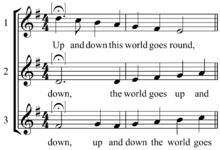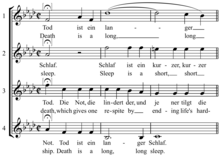What Os It Called to Sing a Song Once Then Again



"Frère Jacques", a traditional four voice round ![]() Play(help·info)
Play(help·info)
A round (also called a perpetual canon [canon perpetuus] or space canon) is a musical limerick, a limited type of catechism, in which a minimum of three voices sing exactly the same melody at the unison (and may go on repeating it indefinitely), but with each voice get-go at dissimilar times so that different parts of the melody coincide in the different voices, but nevertheless fit harmoniously together.[2] It is one of the easiest forms of part singing, as only one line of melody need exist learned by all parts, and is role of a popular musical tradition. They were particularly favoured in glee clubs, which combined amateur singing with regular drinking.[3] The earliest known rounds date from 12th century Europe. One characteristic of rounds is that, "In that location is no fixed ending," in the sense that they may be repeated every bit many times as possible, although many do have "fixed" endings, oftentimes indicated by a fermata.[1]
"Row, Row, Row Your Boat" is a well-known children'south round for iv voices. Other well-known examples are "Frère Jacques", "Three Bullheaded Mice", and, more recently, the outro of "God Only Knows" by The Beach Boys (the first[ citation needed ] usage in contemporary pop music).[iv]
A grab is a circular in which a phrase that is non credible in a single line of lyrics emerges when the lyrics are split between the different voices. "Perpetual canon" refers to the end of the tune leading dorsum to the beginning, allowing easy and immediate repetition. Oft, "the concluding cadence is the same as the first measure".[v]
History [edit]


The term "circular" first appears in English language in the early 16th century, though the grade was found much earlier. In medieval England, they were called rota or rondellus. Subsequently, an alternative term was "roundel" (e.one thousand., David Melvill's manuscript 1 Buik off Roundells, Aberdeen, 1612). Special types of rounds are the "catch" (a comic English class found from most 1580 to 1800), and a specialized utilise of the word "canon", in 17th- and 18th-century England designating rounds with religious texts.[2] The oldest surviving round in English language is "Sumer Is Icumen In" [iv] ![]() Play(help·info) , which is for 4 voices, plus two bass voices singing a basis (that is, a never-irresolute repeating office), also in canon. However, the earliest known rounds are two works with Latin texts found in the eleventh fascicle of the Notre Matriarch manuscript Pluteo 29.one. They are Leto leta concio (a two-voice round) and O quanto consilio (a four-voice round). The former dates from earlier 1180 and may be of German origin.(Falck 1972, pp. 43–45, 57) The commencement published rounds in English were printed by Thomas Ravenscroft in 1609... "Iii Blind Mice"
Play(help·info) , which is for 4 voices, plus two bass voices singing a basis (that is, a never-irresolute repeating office), also in canon. However, the earliest known rounds are two works with Latin texts found in the eleventh fascicle of the Notre Matriarch manuscript Pluteo 29.one. They are Leto leta concio (a two-voice round) and O quanto consilio (a four-voice round). The former dates from earlier 1180 and may be of German origin.(Falck 1972, pp. 43–45, 57) The commencement published rounds in English were printed by Thomas Ravenscroft in 1609... "Iii Blind Mice" ![]() Play(help·info) appears in this collection, although in a somewhat dissimilar form from today's children's round:
Play(help·info) appears in this collection, although in a somewhat dissimilar form from today's children's round:
Three Blinde Mice,
three Blinde Mice,
Dame Iulian,
Dame Iulian,
The Miller and his merry olde Married woman,
shee scrapte her tripe licke thou the knife.
Mechanics [edit]
The canon, or rule, of a simple round is that each voice enters after a set interval of time, at the same pitch, using the same notes.[seven]
What makes a round piece of work is that afterwards the work is divided into equal-sized blocks of a few measures each, respective notes in each block either are the same, or are unlike notes in the same chord. This is easiest with 1 chord, as in "Row, Row, Row Your Boat" ![]() Play(help·info) :
Play(help·info) :

A new part can bring together the singing by starting at the beginning whenever another part reaches whatsoever asterisk in the in a higher place music. If 1 ignores the sixteenth notes that pass between the main chords, every single note is in the tonic triad—in this instance, a C, E, or Yard.
Many rounds involve more than ane chord, as in "Frère Jacques" ![]() Play(assistance·info) :
Play(assistance·info) :

The texture is simpler, simply information technology uses a few more notes; this tin perhaps exist more than easily seen if all four parts are run together into the same two measures:

The 2d beat of each measure does not sketch out a tonic triad, it outlines a dominant seventh chord (or "V7 chord").
Classical [edit]

Serious composers who turned their hand to the round format include Thomas Arne, John Blow, William Byrd, Henry Purcell, Louis Hardin, Joseph Haydn, Wolfgang Amadeus Mozart, Ludwig van Beethoven, and Benjamin Britten (for case, "One-time Joe Has Gone Fishing", sung past the villagers in the pub to keep the peace, at the cease of act 1 of Peter Grimes) .[9] Examples by J. S. Bach include the regular canons, Var. iii and Var. 24 of the Goldberg Variations, and the perpetual canons, Canon 7 of The Musical Offering and Canon a 2 Perpetuus (BWV 1075).[x] Several rounds are included amongst Arnold Schoenberg'south thirty-plus canons, which "within their natural limitations ... are bright pieces, containing too much of the composer's characteristically unexpected alloy of seriousness, sense of humor, vigour and tenderness to remain unperformed".[eleven]
See besides [edit]
- Pervading fake
- Vox crossing
- Voice exchange
References [edit]
- ^ a b MacDonald & Jaeger 2006, p. fifteen.
- ^ a b Johnson 2001.
- ^ Aldrich 1989, p. introductory essay, viii–22, specially at p 21: "Catch-singing is unthinkable without a supply of liquor to manus...".
- ^ a b Hoffman 1997, p. 40.
- ^ Walton 1974, p. 141.
- ^ & Norden 1970, p. 195.
- ^ Mead 2007, p. 371.
- ^ MacDonald & Jaeger 2006, p. viii.
- ^ Howard 1969, p. fifteen.
- ^ Smith 1996.
- ^ Neighbour 1964, p. 681.
Sources [edit]
- Aldrich, Henry (1989). Robinson, B. W.; Hall, R. F. (eds.). The Aldrich Book of Catches. London: Novello.
- Falck, Robert (1972). "Rondellus, Catechism, and Related Types earlier 1300". Periodical of the American Musicological Gild. 25 (1 (Spring)): 38–57.
- Hoffman, Miles (1997). The NPR Classical Music Companion: Terms and Concepts from A to Z. Boston: Houghton Mifflin. ISBN978-0-61-861945-0. .
- Howard, Patricia (1969). The Operas of Benjamin Britten; An Introduction. New York and Washington: Frederick A. Praeger, Publishers.
- Johnson, David (2001). Sadie, Stanley; Tyrell, John (eds.). Round. The New Grove Dictionary of Music and Musicians. London: Macmillan Publishers. ISBN978-one-56-159239-5.
- MacDonald, Margaret Read; Jaeger, Winifred (2006). The Round Book: Rounds Kids Love to Sing. Petty Rock: Baronial House. ISBN978-0-87-483786-five.
- Mead, Sarah (2007). Kite-Powell, Jeffery 343–73 (ed.). Renaissance Theory. A Performer's Guide to Renaissance Music (second ed.). Bloomington: Early Music Found Indiana University Press. ISBN978-0-253-34866-1.
- Neighbour, Oliver W. (1964). "Schoenberg'due south Canon's". The Musical Times. 105 (1459 (September)): 680–81.
- Norden, Hugo (1970). The Technique of Canon. Branden Books. ISBN978-0-82-831839-6.
- Smith (1996). Beefcake of a Canon. The Canons and Fugues of J. S. Bach.
- Walton, Charles Due west (1974). Bones Forms in Music. New York: Alfred Publishing Co. ISBN978-0-88-284010-ix.
murillowastumpaboos.blogspot.com
Source: https://en.wikipedia.org/wiki/Round_%28music%29
0 Response to "What Os It Called to Sing a Song Once Then Again"
Post a Comment